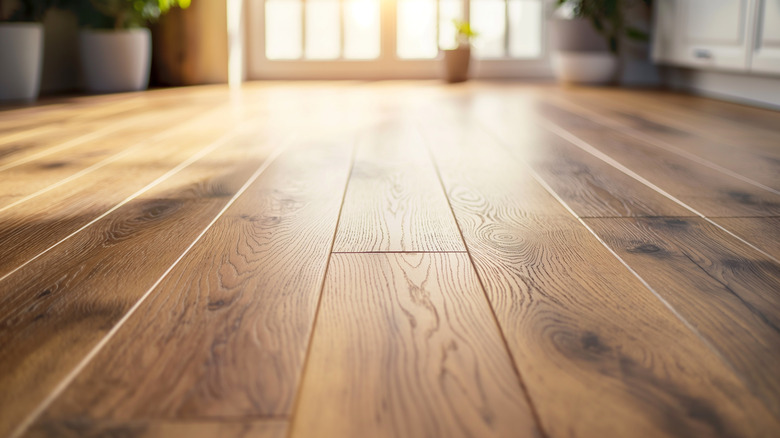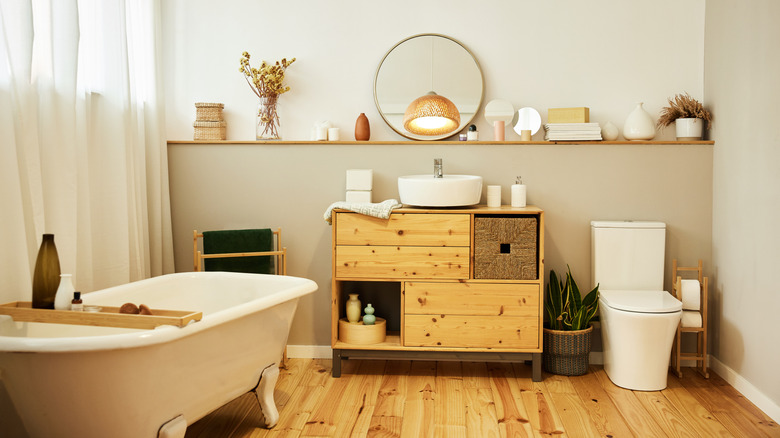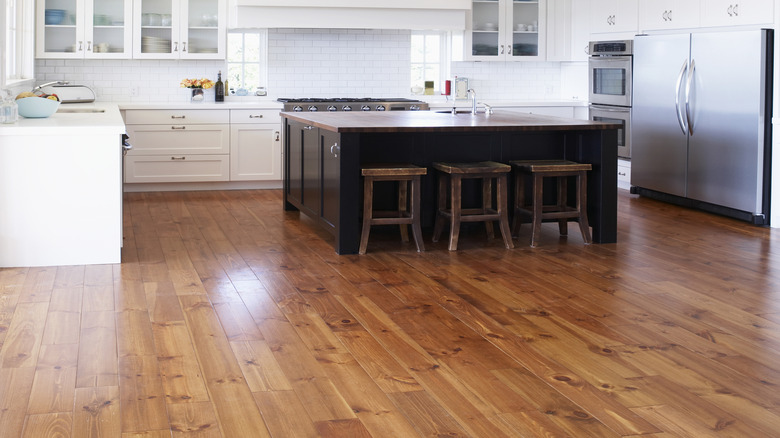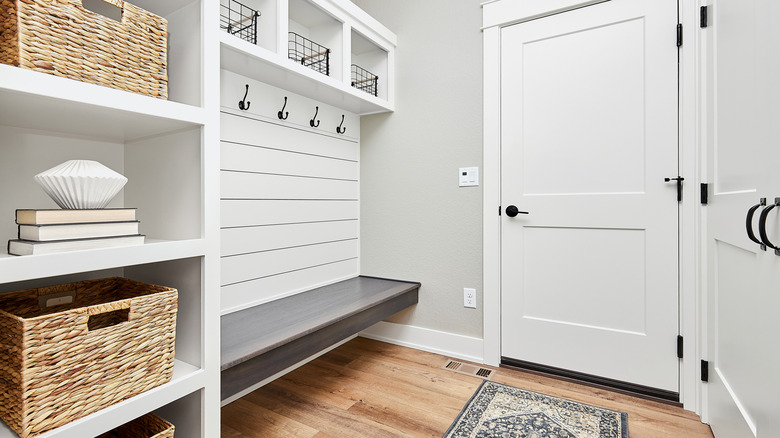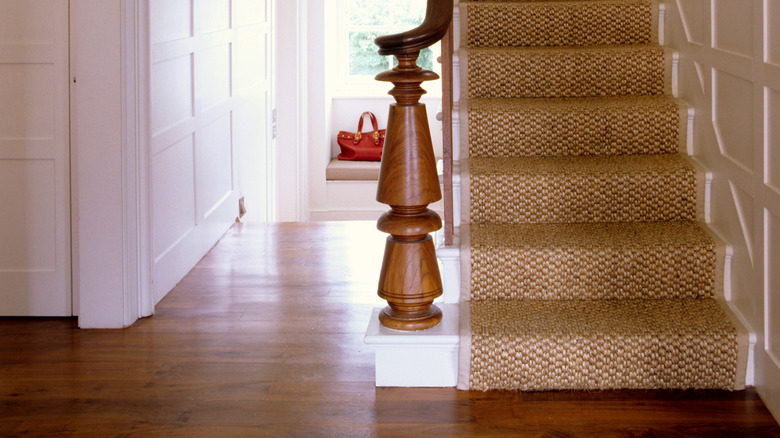Avoid Installing Hardwood Floors In These Areas Of Your Home At All Costs
Hardwood floors are incredibly beloved for a number of reasons. In addition to being a sustainable option, they are also easier to keep clean than carpeted surfaces , can increase your home's value, and offer much greater durability than vinyl flooring. For all there is to love about hardwood, there are also a number of factors to consider if you're thinking about installing this flooring in your home. Chief among those concerns is ensuring that the space in which you choose to install the hardwood is conducive to the needs of the flooring.
While hardwood flooring is generally pretty durable, placing it in an area of the home where conditions are less than ideal will all but guarantee that it doesn't last as long as it should (which would be a shame, given the fact that solid hardwood floors should be able to last up to 100 years with proper care). The top rooms that you should avoid installing your hardwood floors in are bathrooms, laundry rooms, kitchens, mudrooms, and high-traffic hallways. Even though there are many spaces in the home that aren't ideal for hardwood installation, there are always alternatives you can consider that will give you that hardwood floor look without the same potential issues.
Bathrooms and basements
Moisture is no friend of hardwood flooring. Because hardwood is porous, it is capable of absorbing moisture in the air or moisture that accumulates on its surface. Over time, this exposure to moisture and ambient humidity can cause issues like warping and buckling.
Naturally, since high moisture and humidity can be problematic for the health of hardwood flooring, you'll want to steer clear of installing it in spaces like bathrooms. Constant exposure to steam from the shower and drips on the floor can cause you to have to make expensive repairs down the line. This humidity rule applies to other spaces, too — basements that are on the dank side, for example, should be finished with a different flooring type. Additionally, if you reside in an area where the outdoor humidity levels are especially high, such as near the beach, hardwood flooring might not stand the test of time. Similarly, you should avoid installing hardwood floors in indoor-outdoor rooms like screened in patios, which will inevitably come face-to-face with high moisture often.
Kitchens and laundry rooms
Another area that hardwood floors should not be placed in are those that are at risk of regular spills. If high-humidity spaces can cause warping in hardwood floors, you can probably imagine how detrimental standing water can be to this flooring type. As annoying as it is, spills of any kind (water, oil, detergent, etc) will negatively impact the long-term health of your hardwood flooring, leaving you with stains or warped flooring. Additionally, even if you manage to prevent spills from taking place, the risk of damage might make you perpetually on-edge about this potential outcome.
While you will have to be the judge of which rooms in your home are prone to spills, some areas that come to mind are half bathrooms, where guest might spill or splash water, laundry rooms, which may damage hardwood floors if an appliance has a leak or if detergent, fabric softener, or cleaning supplies spill, or kitchens, which are no stranger to regular drips and spills. If your home has additional spaces that check the box on being prone to regular spills, you'll want to add those to the list of rooms to avoid hardwood installation in.
Mudrooms
Beyond simply protecting your hardwood floors from moisture, humidity, and spills, you also need to stay on top of keeping them clean. Yes, there is an expectation that floors will be exposed to everyday grime, but if a room or space in your home is subjected to excessively high amounts of mud, dirt, or sand, you'll be faced with a world of trouble. Dirt and mud can penetrate natural cracks in hardwood or spaces between the pieces of hardwood (which is common with older hardwood floors), which can result in discoloration or scratching the surface of the wood.
Some spaces in the home that might be exceptionally dirty or muddy include the areas in front of doorways, mudrooms, foyers, or hallways connecting to foyers. You will have to take extra care in where you install hardwood floors if you have dogs or children who are prone to tracking in mud from the front or backyard. Purchasing the best doorway rugs for your entryways can help to keep your hardwood floors clean and protected if there's only a small area that frequently gets dirty, but it's best to avoid installing wood flooring altogether if you don't want to have to be on constant cleanup duty in these spaces.
High-traffic hallways
The last area in your home that you'll want to avoid installing hardwood floors in is any area that is considered to have high levels of foot traffic. While floors are designed to stand up to regular use, some homes have pathways (such as a single central hallway) that are responsible for routing most, if not all, foot traffic on a daily basis. Heavy foot traffic can result in damages to the protective layer of your hardwood floors in the form of dents, scratches, or the wearing away of the wood's finish.
Since constant traffic will likely mean that your wood floors don't last as long as they would otherwise, you might need to consider another type of flooring if you have a busy home or a large family. High traffic areas that are not necessary thoroughfares in the home (such as a living room) can also be at risk for excessive wear and tear if your furniture is always arranged in one pattern. You can help to keep your wood floors looking nice with one simple trick: moving your furniture from time to time. This will even out the foot traffic that a space receives, helping your hardwood floors to wear more evenly over the years.
Alternatives to consider
If you had your heart set on hardwood floors for any of the aforementioned spaces in the home, there's no need to be overly disappointed. There are many flooring options that you can consider when hardwood isn't a good choice. Should you be partial to a natural and sustainable option, bamboo flooring can be a wonderful alternative to traditional hardwood. It's more durable than conventional hardwood and should hold up well to foot traffic and daily messes, so long as it has a good protective finish on it. You'll still, however, want to avoid using bamboo flooring in bathrooms, basements, or laundry rooms, as it can warp. Laminate is another good option for high-traffic hallways and mudrooms. You'll want to avoid using it in laundry rooms, bathrooms, and kitchens, though.
For those moisture-ridden areas in the home, such as bathrooms, basements, kitchens, and laundry rooms, vinyl plank flooring could be right for your space. Benefits of vinyl flooring include its durability and the fact that it is waterproof, giving you significant peace of mind. Unfortunately, this flooring type is not a perfect alternative to hardwood. It can dent easily and leach volatile organic compounds (VOCs), making it less-than-ideal for homes that are seeking to be toxin-free.
With the right knowledge, you can have confidence that you're installing hardwood flooring in the right areas. If you inherited a home where hardwood floors were installed in the wrong spaces, however, it's not the end of the world. You can bring your old hardwood floors back to life in a number of ways, from giving them a simple polish to completely refinishing their surface.
